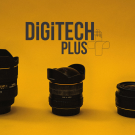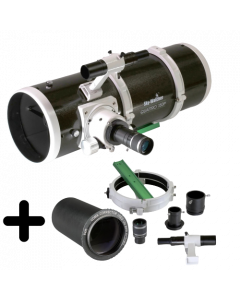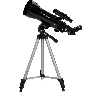Sky-Watcher Quattro 150-P (F4) Telescope Review
Sky-Watcher Quattro 150-P (F4) Telescope Review
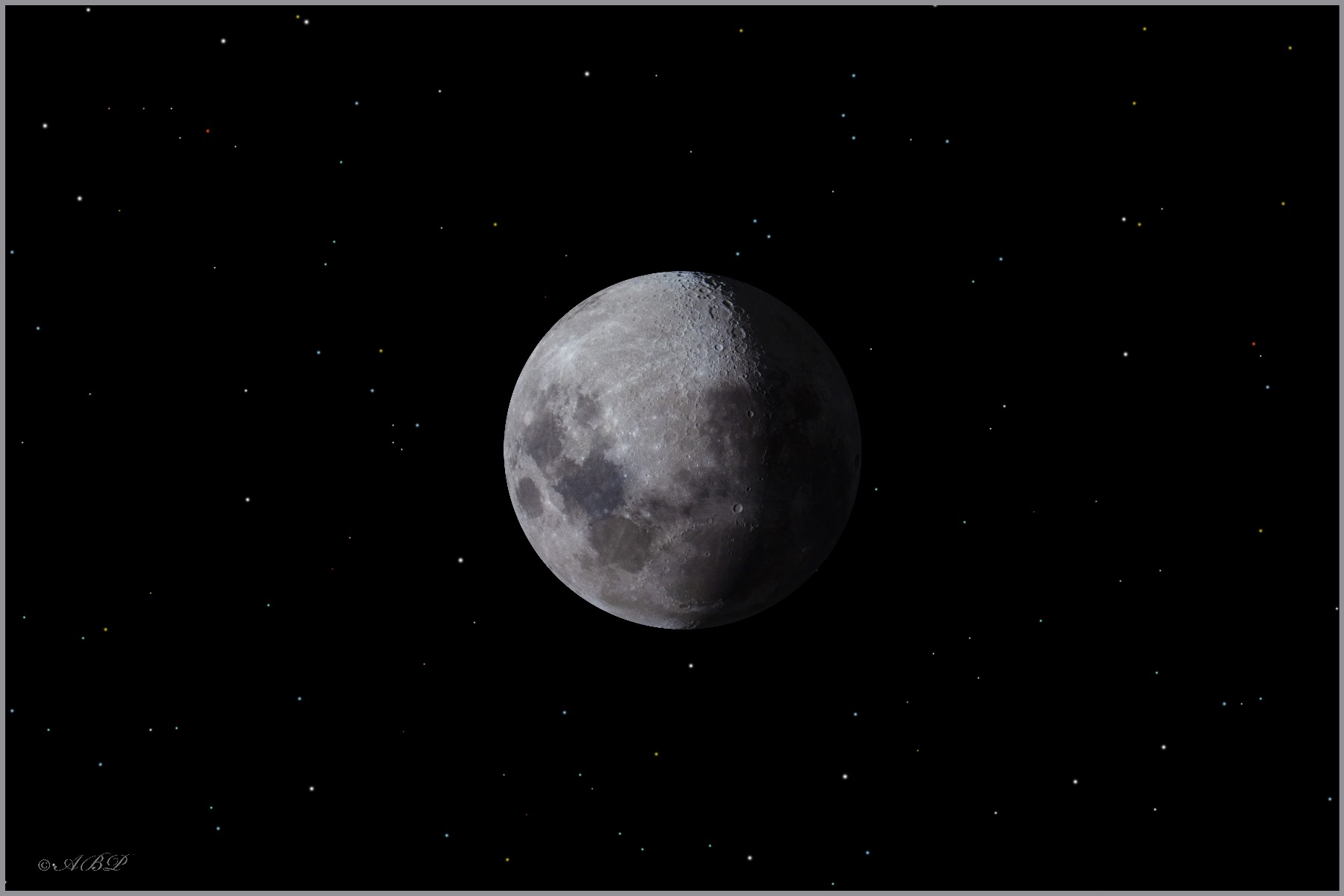
Sky-Watcher has developed a new astrophotography telescope to add to their already impressive range. This time it’s a Newtonian reflector that in true Newtonian design, uses two mirrors (a large primary and smaller, angled secondary mirror) to direct light towards the eyepiece or camera.
A few nights after unboxing, I set the scope up and attached my Canon 60Da DSLR to capture a quick test shot of the moon. I was suitably impressed with the crisp view through the laptop screen and great, wide-field image that resulted from the test shot (note: I added a starry background for extra effect and the image above was the result).
 |
 |
As luck would have it, the “astronomers curse” then took effect and poor weather conditions rolled in that literally persisted for months until November 2023 when I was afforded an opportunity to point the telescope at a couple of deep sky objects to gauge how the scope performs under the night sky. More on that in a bit…
Sky-Watcher Quattro 150-P Technical Specs
In summary, here are the basic specifications:
- Scope Design:Newtonian Reflector
- Diameter:150mm
- Focal Length:600mm
- F-Ratio:f/4
- Focuser:Dual-Speed 10:1 Crayford Power Focuser
- Mounting Style:Tube Rings with Vixen-style dovetail bar
- Weight:7kgs
- Finderscope: 6x30
- Accessories: M48 2” aplanatic super coma corrector / x0.9 reducer & 70° Ultra wide 22mm eyepiece
- Image Circle: 7mm (with x0.9 reducer attached)
Unboxing
My first impression after unboxing the telescope was that this is a very light, portable little scope with several useful accessories included. The telescope arrived in a standard Sky-Watcher box with all the components neatly and safely packaged with appropriate padding to protect the scope and accessories. The fact that it is accompanied by a coma corrector / x0.9 reducer and wide field eye piece is an extra selling point for this well priced telescope.
Design features
The inclusion of a x0.9x reducer is a nice touch to this entry level astrograph. This effectively takes the telescope down to a faster f3.45 scope which means more data collected in less time when using it for astrophotography.
The 150mm parabolic mirror is a reminder of the great quality that Sky-Watcher is renowned for. Specifically, the Quattro has silicon dioxide mirror coatings that provide adequate protection from the elements and when combined with the fact that this scope is a fast f3.45, the design lends itself to contexts where imaging needs to be fast and effective if the weather is against you.
It was easy to connect my DSLR and ZWO294mc pro camera to the telescope and achieve back focus without any trouble making for a smooth astro-imaging experience.
How does the scope perform under night skies as an observing instrument?
Using the 70° Ultra wide 22mm eyepiece (provided with the scope) was a visual delight with the telescope providing excellent views of the night sky. In particular the Pleiades and Orion Nebula looked breathtaking to the eye. I also took a turn by the Hyades and then a little later, visited the Jewel Box cluster near Crux. Jupiter and Saturn also looked glorious through the eyepiece with their moons and some surface features well visible after I switched to my personal 9mm eyepiece. With a 2x Barlow lens, I am certain this scope would reveal some amazing planetary and lunar details.
The Verdict for Astrophotography?
Having had months of cloudy, hazy skies and windy conditions, I was excited to connect my ZWO294mc Pro camera to this little light bucket and see what imaging results would be like over a relatively short period of time under one of the clearer nights we have enjoyed in a while. I allocated 1 and ½ hours per object and settled on imaging the Orion/Running Man Nebulae and Pleaides. Frustratingly the earlier cloud-free skies began to show signs of high-altitude moisture with faint patches of haze and cloud appearing during the session. Despite this issue, I persevered and after having to discard a number of light subs, was able to produce the following images for this review:
 |
 |
For the Orion/Running Man Nebula, I used 30 second subs (gain 121 / temp-10) and captured 180 of them (with relevant flats and darks). I discarded 25 subs due to clouds and haze (total integration time was thus 1 hour and 17 mins). I would have liked to capture a few shorter subs to bring out more detail in the slightly overexposed core area but in the interests of testing the scope on the Pleiades before the weather changed, opted to move onto that target. At this stage the sky had turned quite hazy as a result of high altitude moisture but I continued nontheless and captured an additional 180 subs at 30 seconds each (gain 121 / temp-10). I discarded 30 subs due to clouds and used the remaining 150 (total integration 1 hour and 15 mins). Despite more data being needed, the Sky-Watcher Quattro 150-P delivered the goods and I was suitably impressed.
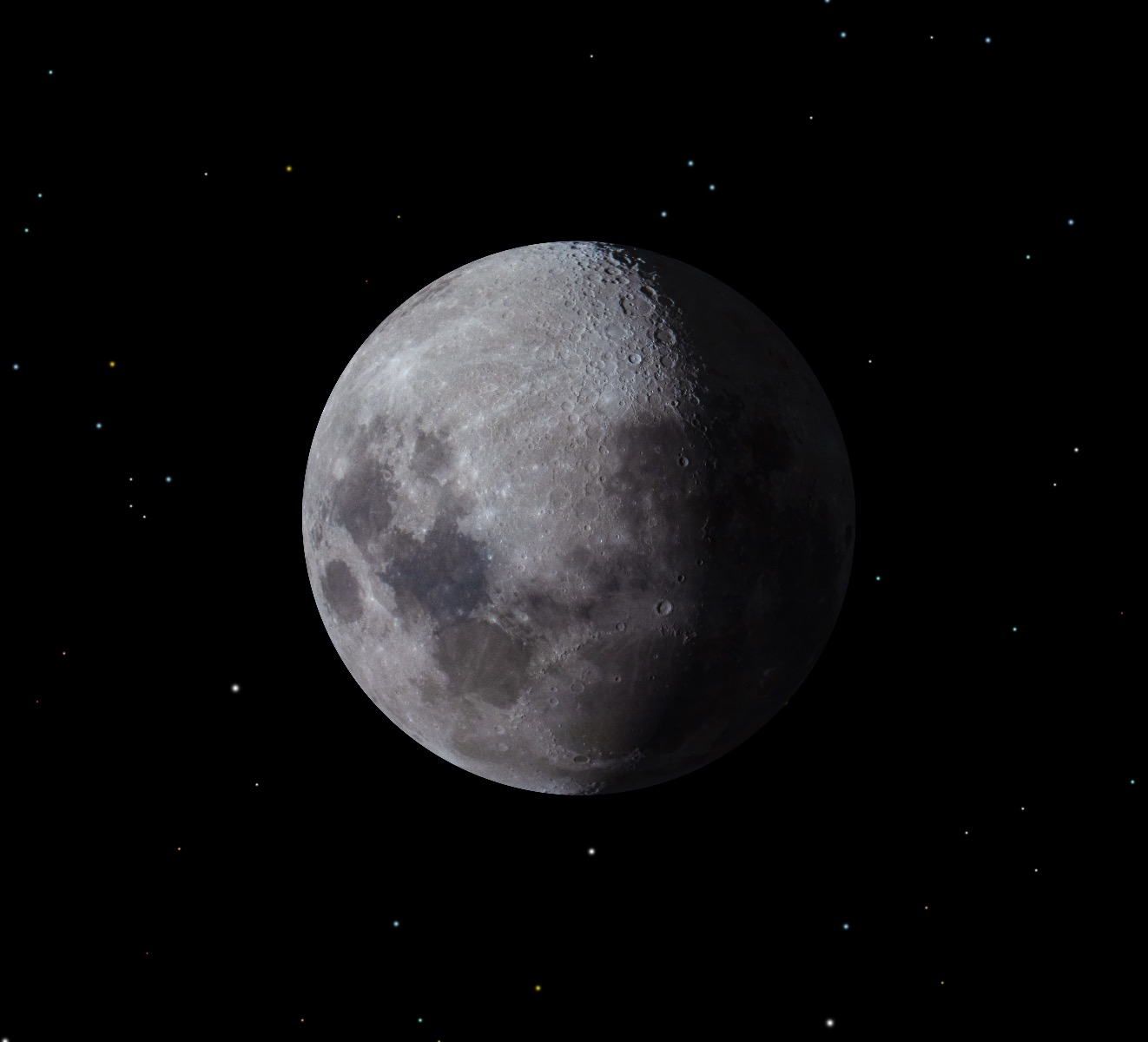 |
|
In Conclusion
The Sky-Watcher Quattro 150-P is a well-priced astrograph with accessible design features. It can (as with most telescopes) benefit from accessorizing to suit your specific needs and experience levels but for a beginner wanting a scope that is both a versatile observing instrument and able to deliver great astro images, this should certainly be considered as a highly recommended choice. It’s important to note that most Newtonian Reflectors need some type of collimation before use (which thankfully wasn’t needed for this scope when reviewing it). It is important to remember this if you purchase one as it is a relatively simple process (and will save you any potential frustration when using it for astro-imaging).
The inclusion of all required connections, an eyepiece, finderscope and M48 2” aplanatic super coma corrector / x0.9 reducer makes this telescope a bargain.
Copyright - Angus Burns, South Africa, December 2023


